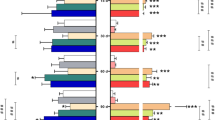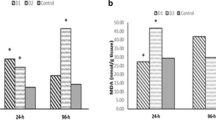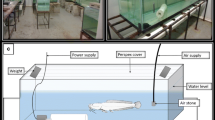Abstract
This study’s hypothesis is that carbofuran and copper sulfate have a synergistic harmful impact on the fertility of male Nile tilapia. Hence, this study was designed to assess the toxic reproductive outcome of carbofuran, copper sulfate, and their mixture in male Nile tilapia. Sixty male Nile tilapia fishes were separated into four groups (15 fish/group). The control group; carbofuran group, was given dechlorinated tap water containing 0.02 mg/L (1/10 dose of LC50) carbofuran; copper group was given dechlorinated tap water containing 4.0 mg/L (1/10 dose of LC50) copper sulfate; carbofuran + copper sulfate group received dechlorinated tap water containing 0.02 mg/L carbofuran plus 4.0 mg/L copper sulfate. After 6 weeks, results revealed a significant rise in testicular malondialdehyde levels and a significant decrease in testicular reduced glutathione contents among all experimental groups compared to the control group. Testicular testosterone levels were significantly declined in copper and combined groups compared to the control. The seminal evaluation using computer-assisted sperm analysis showed a significant decline in the progressive motility percentage, motile ratio percentage, sperm concentration, curvilinear velocity, straight-line velocity, average path velocity, and wobble in all intoxicated groups, particularly, the combined group. The histopathology of testes in all intoxicated groups revealed a detachment of the basal membrane of some seminiferous tubules, and others were free from spermatogonia and spermatozoa with interstitial eosinophilic granular cell infiltration. Testicular lesions were more severe in the combined group. Finally, it was concluded that carbofuran and copper sulfate exerted a negative effect on the reproductive function of male Nile tilapia, and they have a synergistic harmful impact on the fertility of male Nile tilapia.


Similar content being viewed by others
Data availability
All data generated and analyzed during our study are included in this article.
References
Abascal FJ, Cosson J, Fauvel C (2007) Characterization of sperm motility in sea bass: the effect of heavy metals and physicochemical variables on sperm motility. J Fish Biol 70:509–522
Abdel-Hamid EAA, Hashem SH, Ghareib AA (2021) The effect of a mixture of environmental pollutants on some biomarkers in the Nile tilapia (Oreochromis niloticus). Egypt J Aquat Biol Fish 25:659–675
Abdel-Khalek AA, Badran SR, Marie MS (2020) The efficient role of rice husk in reducing the toxicity of iron and aluminum oxides nanoparticles in Oreochromis niloticus: hematological, bioaccumulation, and histological endpoints. Water Air Soil Pollut 231:1–10
Abdel-Khalek AA, Kadry MAM, Badran SR, Marie MS (2015) Comparative toxicity of copper oxide bulk and nano particles in Nile tilapia; Oreochromis niloticus:biochemical and oxidative stress. J Basic Appl Sci 72:43–57
Abdel-Satar AM, Ali MH, Goher ME (2017) Indices of water quality and metal pollution of Nile River. Egypt Egypt J Aquat Res 43:21–29
Abe FR, Machado AA, Coleone AC, Cruz C, Machado-Neto JG (2019) Toxicity of diflubenzuron and temephos on freshwater fishes: ecotoxicological assays with Oreochromis niloticus and Hyphessobrycon eques. Water Air Soil Pollut 230:1–10
Afonso LO, Wassermann GJ, De Oliveira RT (2001) Sex reversal in Nile tilapia (Oreochromis niloticus) using a nonsteroidal aromatase inhibitor. J Exp Zool 290:177–181
Agarwal A, Saleh RA, Bedaiwy MA (2003) Role of reactive oxygen species in the pathophysiology of human reproduction. Fertil Steril 79:829–843
Aly W, Abouelfadl KY (2020) Impact of low-level water pollution on some biological aspects of redbelly tilapia (Coptodon zillii) in River Nile. Egypt Egypt J Aquat Res 46:273–279
Baker MA, Aitken RJ (2004) The importance of redox regulated pathways in sperm cell biology. Mol Cell Endocrinol 216:47–54
Bancroft JD, Gamble M (2013) Theory and practice of histological techniques, 7th edn. Churchill Livingstone, Edinburgh, p 252
Barbieri E, Ferrarini AMT, Rezende KFO, Martinez DST, Alves OL (2019) Effects of multiwalled carbon nanotubes and carbofuran on metabolism in Astyanax ribeirae, a native species. Fish Physiol Biochem 45:417–426
Bombardelli RA, Neumann G, Toledo CP, Sanches EA, Bastos DN, Oliveira JD (2016) Sperm motility, fertilization, and larval development of silver catfish (Rhamdia quelen) in copper-contaminated water. Semin Cienc Agrar 37:1667–1678
Colborn T, vom Saal FS, Soto AM (1993) Developmental effects of endocrine-disrupting chemicals in wildlife and humans. Environ Health Perspect 101:378–384
Demetrious JA (1987) Testosterone in methods. In: Methods in clinical chemistry, Pesce AJ, Kaplan LA (Eds.). Mosby, Los Angles, p 268
Di Guardo F, Vloeberghs V, Bardhi E, Blockeel C, Verheyen G, Tournaye H, Drakopoulos P (2020) Low testosterone and semen parameters in male partners of infertile couples undergoing IVF with a total sperm count greater than 5 million. J Clin Med 9:3824
EPA US (1995) Carbofuran. Office of Water, U.S. Environmental Protection Agency, Washington, D.C.
Gadagbui BKM, Addy M, Goksøyr A (1996) Species characteristics of hepatic biotransformation enzymes in two tropical freshwater teleosts, tilapia (Oreochromis niloticus) and mudfish (Clarias anguillaris). Comp Biochem Physiol 114C:201–211
Gage MJ, Macfarlane CP, Yeates S, Ward RG, Searle JB, Parker GA (2004) Spermatozoal traits and sperm competition in Atlantic salmon: relative sperm velocity is the primary determinant of fertilization success. Curr Biol 14:44–47
Guo SN, Zheng JL, Yuan SS, Zhu QL (2018) Effects of heat and cadmium exposure on stress-related responses in the liver of female zebrafish: heat increases cadmium toxicity. Sci Total Environ 618:1363–1370
Hamed HS, Ismal SM, Faggio C (2021) Effect of allicin on antioxidant defense system, and immune response after carbofuran exposure in Nile tilapia, Oreochromis niloticus. Biochem Physiol C Toxicol Pharmacol 240:108919
Harabawy ASA, Ibrahim ATA (2014) Sublethal toxicity of carbofuran pesticide on the African catfish Clarias gariepinus (Burchell, 1822): hematological, biochemical and cytogenetic response. Ecotoxicol Environ Saf 103:61–67
Ibrahim AT, Harabawy AS (2014) Sublethal toxicity of carbofuran on the African catfish (Clarias gariepinus): hormonal, enzymatic and antioxidant responses. Ecotoxicol Environ Saf 106:33–39
Jezierska B, Witeska M (2001) Metal toxicity to fish. University of Podlasie Publisher, Siedlce, p 318
Jobling S, Coey S, Whitmore JG, Kime DE, Van Look KJ, McAllister BG, Beresford N, Henshaw AC, Brighty G, Tyler CR, Sumpter JP (2002) Wild intersex roach (Rutilus rutilus) have reduced fertility. Biol Reprod 67:515–524
Kholodnyy V, Gadêlha H, Cosson J, Boryshpolets S (2020) How do freshwater fish sperm find the egg? The physicochemical factors guiding the gamete encounters of externally fertilizing freshwater fish. Rev Aquacult 12:1165–1192
Kime DE, Van Looka KJ, McAllister BG, Huyskensb G, Rurangwab E, Ollevier F (2001) Computer-assisted sperm analysis (CASA) as a tool for monitoring sperm quality in fish. Comp Biochem Phys C 130:425–433
Kirici M, Turk C, Caglayan C, Kirici M (2017) Toxic effects of copper sulphate pentahydrate on antioxidant enzyme activities and lipid peroxidation of freshwater fish acpoeta umbla (Heckel, 1843) tissues. Appl Ecol Environ Res 15:1685–1696
Konradsen F, Van der Hoek W, Cole DC, Hutchinson G, Daisley H, Singh S, Eddleston M (2003) Reducing acute poisoning in developing countries-options for restricting the availability of pesticides. Toxicol 192:249–261
Kumar S (2004) Occupational exposure associated with reproductive dysfunction. J Occup Health 46:1–19
Lahnsteiner F, Mansour N, Berger B (2004) The effect of inorganic and organic pollutants on sperm motility of some freshwater teleosts. J Fish Biol 65:1283–1297
Liu G, Chai X, Shao Y, Hu L, Xie Q, Wu H (2011) Toxicity of copper, lead, and cadmium on the motility of two marine microalgae Isochrysis galbana and Tetraselmis chui. JBES 23:330–335
Malhotra N, Ger T, Uapipatanakul B, Huang J, Chen K, Hsiao C (2020) Review of copper and copper nanoparticle toxicity in fish. Nanomaterials 10:1126
Mishu AM, Mostakim GM, Khatun MtM, Rahman MdK, Shahjahan Md, Islam MS (2020) Sperm movement and morphological changes in the silver barb (Barbonymus gonionotus) exposed to quinalphos. Environ Sustainab Indic 8:100083
Mohamed WA, El-Houseiny W, Ibrahim RE, Abd-Elhakim YM (2019) Palliative effects of zinc sulfate against the immunosuppressive, hepato- and nephrotoxic impacts of nonylphenol in Nile tilapia (Oreochromis niloticus). Aquac 504:227–238
Ohkawa H, Ohishi N, Yagi K (1979) Assay for lipid peroxides in animal tissues by thiobarbituric acid reaction. Anal Biochem 95:351–358
Ong CN, Shen HM, Chia SE (2002) Biomarkers for male reproductive health hazards: are they available? Toxicol Lett 134:17–30
Rurangwa E, Kime DE, Ollevier F, Nash JP (2004) The measurement of sperm motility and factors affecting sperm quality in cultured fish. Aquac 234:1–28
Sanches EA, Bombardelli RA, Marcos RM, Neumann G, Rebechi de Toledo CP, Romagosa E (2010) Sperm motility of Rhamdia quelen studied using computer-assisted analysis by open-source software. Aquac Res 42:153–156
Sedlak J, Lindsay RH (1968) Estimation of total protein-bound and nonprotein sulfhygroups in tissue with Ellman’s reagent. Anal Biochem 25:192–205
Shalaby SEM, Abdou GY (2020) Assessment of pesticide residues in blood samples of agricultural workers in Egypt. J Plant Prot Res 60:369–376
Shaw BJ, Al-Bairuty G, Handy RD (2012) Effects of waterborne copper nanoparticles and copper sulphate on rainbow trout (Oncorhynchus mykiss): physiology and accumulation. Aquat Toxicol 116–117:90–101
Stephan C (1977) Methods for calculating an LC50. In: Mayer F, Hamelink J (eds) Aquatic toxicology and hazard evaluation. ASTM International, West Conshohocken, pp 65–84
Tunçsoy M, Erdem C (2018) Copper accumulation in tissues of Oreochromis niloticus exposed to copper oxide nanoparticles and copper sulphate with their effect on antioxidant enzyme activities in liver. Water Air Soil Pollut 229:269
USEPA (2006) Interim reregistration eligibility decision–carbofuran. U.S. Environmental Protection Agency, Washington DC EPA- 738-R: 706–031
Wilson-Leedy JG, Ingermann RL (2007) Development of a novel CASA system based on open source software for characterization of zebra fish sperm motility parameters. Theriogenol 67:661–672
Wirtz S, Steinmann P (2006) Sperm characteristics in perch Perca fluviatilis L. J Fish Biol 68:1896–1902
Zhou B, Liu W, Siu WH, Toole DO, Lam PK, Wu RS (2006) Exposure of spermatozoa to duroquinone may impair reproduction of the common carp (Cyprinus carpio) through oxidative stress. Aquat Toxicol 77:136–142
Zitoun R (2019) Copper speciation in different marine ecosystems around New Zealand (Thesis, Doctor of Philosophy) University of Otago, Dunedin
Acknowledgements
We would thank Professor Dr. Mahmoud M. A. Elmaghraby for performing the statistical analyses.
Author information
Authors and Affiliations
Contributions
Conceptualization and methodology: Tohamy HG and Abou-Srag MA. Investigation and data collection were performed by Abou-Srag MA, Oda SS, and Tohamy HG. Figures were made by Tohamy HG. Oda SS and Tohamy HG wrote the manuscript. The supervision was by El-Manakhly EM. All the authors read and agreed the final manuscript. Oda SS is the corresponding author.
Corresponding author
Ethics declarations
Ethics approval
Not applicable.
Consent to participate and consent for publication
Not applicable.
Conflict of interest
The authors declare no competing interests.
Additional information
Communicated by Bruno Nunes.
Publisher's note
Springer Nature remains neutral with regard to jurisdictional claims in published maps and institutional affiliations.
Rights and permissions
About this article
Cite this article
Oda, S.S., El-Manakhly, ES.M., Abou-Srag, M.A. et al. Assessment of reproductive toxicity of carbofuran and copper sulfate in male Nile tilapia (Oreochromis niloticus). Environ Sci Pollut Res 29, 15896–15904 (2022). https://doi.org/10.1007/s11356-021-16965-x
Received:
Accepted:
Published:
Issue Date:
DOI: https://doi.org/10.1007/s11356-021-16965-x




